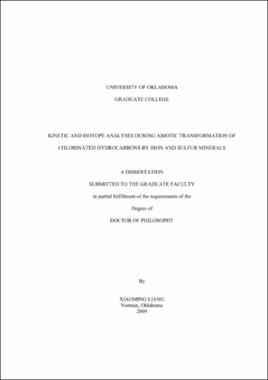| dc.contributor.advisor | Butler, Elizabeth C | |
| dc.creator | Liang, Xiaoming | |
| dc.date.accessioned | 2019-05-01T17:25:23Z | |
| dc.date.available | 2019-05-01T17:25:23Z | |
| dc.date.issued | 2009 | |
| dc.identifier | 99140677502042 | |
| dc.identifier.uri | https://hdl.handle.net/11244/319498 | |
| dc.description.abstract | Abiotic reductive dechlorination of tetrachloroethylene (PCE), trichloroethylene (TCE), and carbon tetrachloride (CT) by naturally occurring minerals was investigated in this study. The kinetics and in some cases stable carbon isotope fractionation associated with abiotic reductive dechlorination of PCE and TCE by model Fe(II)-bearing minerals present in anaerobic soils were measured. The minerals studied were FeS, chloride green rust (GR-Cl), sulfate green rust (GR-SO4), pyrite, magnetite, and adsorbed Fe(II) or FeS formed at the surface of goethite by treatment with dissolved Fe(II) or S(-II). Significant carbon isotope fractionation was observed during PCE dechlorination by FeS and TCE transformation by FeS, GR-Cl and pyrite. Bulk enrichment factors (εbulk) (in /) for PCE dechlorination by FeS were -30.2  4.3 / (pH 7), -29.54  0.83 / (pH 8), and -24.6  1.1 / (pH 9). εbulk values for TCE transformation were -33.4  1.5 / for FeS at pH 8, -27.9  1.3 / for FeS at pH 9, -23.0 ± 1.8 / for GR-Cl at pH 8, and -21.7 ± 1.0 / for pyrite at pH 8. εbulk values for abiotic PCE and TCE transformation are generally more negative than those for microbial dechlorination of PCE and TCE. For monitored natural attenuation, very large negative εbulk values for abiotic PCE and TCE transformation in this research can provide one line of evidence that abiotic degradation of PCE and TCE takes place at field sites. Other lines of evidence (e.g., identification and isotope analysis of reaction products) are also needed in order to make the better assessment of contaminant fate. | |
| dc.description.abstract | Abiotic reductive dechlorination of PCE and TCE was dominant under the iron-reducing condition at pH 8.2 for Duck Pond microcosm and for Landfill microcosm, which may be due to the inactivity of dechlorinating bacteria. Comparable abiotic and biotic transformation was observed in five microcosms, including Duck Pond microcosm under methanogenic condition at pH 8.2, Landfill microcosms at pH 8.2 under iron-reducing and methanogenic conditions, and Landfill microcosms under sulfate-reducing condition at both pH 7.2 and 8.2. Four of these microcosms were conducted at pH 8.2 while only one microcosm was set up at pH 7.2. This provides additional evidence that at least in some cases high pH (8.2) may inhibit the growth of dechlorinating bacteria. In addition, no abiotic reaction products were detected in the three microcosms (Duck Pond and Landfill microcosms under methanogenic condition at pH 7.2, and unamended Landfill microcosms at pH 7.2), which typically had lower concentrations of Fe(II) or S(-II) species than did microcosms preincubated under iron or sulfate reducing conditions. | |
| dc.description.abstract | Widespread natural organic matter (NOM) may significantly influence the fate of contaminants in subsurface environment. In this study, a series of model NOM compounds were selected that have functional groups common to actual NOM in order to study NOM adsorption and its effects on the degradation of carbon tetrachloride by GR-Cl. The amount of NOM adsorbed on the mineral surface were found to depend on the number and positions of functional groups present in NOM. Strong adsorption was found for NOM with multiple carboxylic or phenolic groups on ortho- positions. Adsorption of NOM on GR-Cl was successfully modeled by using Langmuir equation, and adsorption equilibrium constants (K) and maximum adsorption capacity values (qmax-Langmuir) were derived from Langmuir isotherms. K values varied from 218 ± 127 L/mmole to 0.58 ± 0.13 L/mmole, suggesting that different affinity of GR-Cl for selected 10 NOM model compounds. We calculated the theoretical maximum amounts of NOM compounds (qmax-BET) that can be adsorbed on the external surface of GR-Cl using BET surface area of the mineral and the occupation area of NOM anions. Comparisons between qmax-Langmuir and qmax-BET values for selected NOM compounds suggest the possibility that both ligand-exchange and anion intercalation are responsible for the adsorption of NOM on GR-Cl. Effects of NOM adsorption on the reduction of CT are compound-dependent. Although most NOM compounds significantly slowed CT degradation by GR-Cl due to competitive adsorption on reactive sites, caffeic acid greatly increased the CT reduction rate, which may be due to the generation of new Fe (II) sites associated with GR-Cl surface. High chloroform yields (in %) (> 70%) were observed for CT reduction by GR-Cl (both alone and with the addition of NOM). | |
| dc.format.extent | 156 pages | |
| dc.format.medium | application.pdf | |
| dc.language | en_US | |
| dc.relation.requires | Adobe Acrobat Reader | |
| dc.subject | Tetrachloroethylene--Deterioration | |
| dc.subject | Trichloroethylene--Deterioration | |
| dc.subject | Carbon tetrachloride--Deterioration | |
| dc.subject | Groundwater--Pollution | |
| dc.subject | Hazardous wastes--Natural attenuation | |
| dc.title | Kinetic and isotope analyses during abiotic transformation of chlorinated hydrocarbons by iron and sulfur minerals | |
| dc.type | text | |
| dc.type | document | |
| dc.thesis.degree | Ph.D. | |
| ou.group | College of Engineering::School of Civil Engineering and Environmental Science | |
